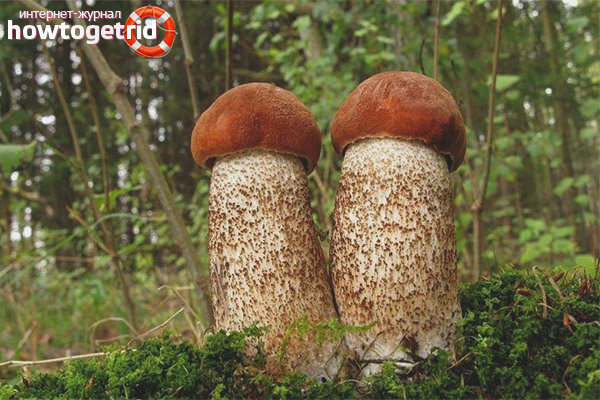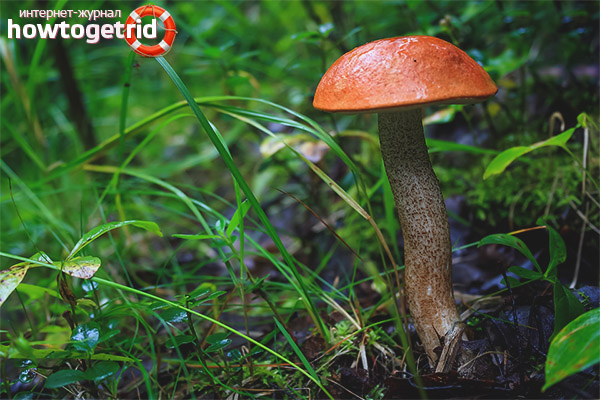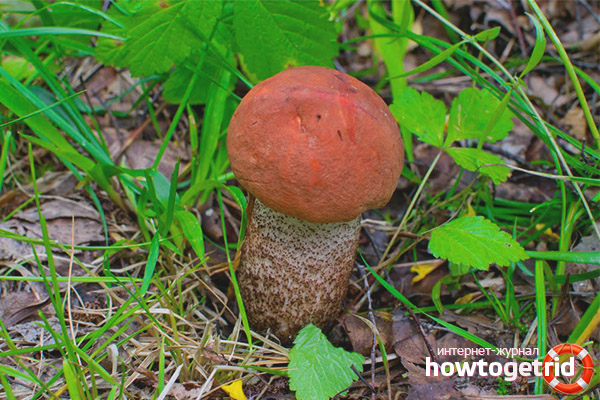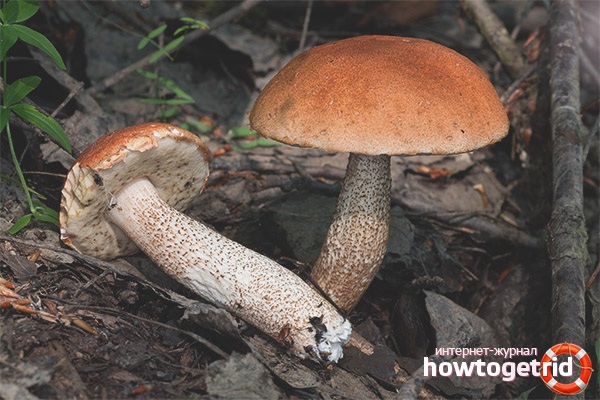The content of the article
The species of mushrooms belonging to the red boletus is a member of the Boletovy family, the genus Leccinum. This mushroom has many other names. Krasnyuk, aspen, red mushroom, krasnik, red-headed - all these are synonyms for the name boletus. In Latin, its name sounds like Leccinum aurantiacum.
general description
A mushroom cap in diameter can reach 15 cm. But there are specimens with much larger sizes. When the mushroom is young, the shape of its cap approaches the hemisphere. In adulthood, it can take the form of a half. The edges of the hat are pressed tightly. This part of the fungus is colored red, but specimens with a brown-red and orange hue can be found. On a hat there is a skin of smooth or velvety character to the touch. Of course, it is possible to separate it from the cap, but it is possible with great difficulty.
The color of the hat depends on where the mushroom grows. If aspen prevails in the forest, then a boletus with a dark red hat is found. In the forests with trees represented by poplars, gray aspen trees grow. In other forests, the color of the mushroom cap is characterized by the presence of various shades.
The flesh of the cap is characterized by the presence of pronounced density and meatiness. As it grows, it softens. The leg is characterized by the presence of pulp of a fibrous structure. On the cut under the influence of oxygen, it quickly acquires a blue color. Then it generally takes on a black tint. The pulp does not have a special taste and smell.
In what places does boletus grow
They grow in deciduous and mixed forests. As a rule, they prefer to be located under a young tree. The most preferred trees for them are aspen and poplar. Sometimes they can be found under other trees. Mushrooms can grow along forest roads, clearings, lawns. Fruiting is carried out with the presence of small groups. The European part of our country, the Urals, Siberia, the Far East, the Caucasus are the territories where you can meet this mushroom.
Actively fruit boletus in the period from June to October. The greatest yield of these mushrooms can be harvested in aspen grove, small deciduous forests. If the summer is dry, mushrooms prefer to hide in wet growth. Peak fruiting in different species of boletus occurs in different periods of the mushroom season. For example, the collection of deciduous trees is characterized by the very mass and duration. They can be collected from late summer to September.
Eating

Red-headed mushroom is undoubtedly edible. It is characterized by the presence of a large selection of cooking methods. They are pickled, stewed, boiled, fried. During heat treatment, the boletus darkens. In order to prevent this from happening, it should first be soaked in a solution of citric acid. When pickling, aspen mushrooms do not change their color.
False boletus: differences
No one will argue that the boletus is undoubtedly beautiful. Moreover, it can be safely attributed to the safest mushrooms. In the vast majority, all types of boletus can be eaten. An experienced mushroom picker, knowing this mushroom well, which is called "in person", boldly collects aspen mushrooms and fearlessly eats them. However, there is not the slightest shadow of a doubt that poisoning will not happen.
However, the literature describes the case of poisoning by boletus. The place of their collection was North America. But there are no specific data on what types of boletus were eaten.
A beginner mushroom picker may ask about the possibility of the existence of false boletus. An experienced mushroom picker will affirmatively say that such mushrooms do not exist in nature. But this species of representatives of the mushroom kingdom is easily confused with the bile fungus. But it is he who is poisonous. This mushroom is also called mustard. But, if you take a closer look at it, then it has a very distant resemblance to the boletus.
Mushrooms differ both in taste and in appearance. The bile fungus has a bitter taste. If you cut the legs, then it becomes pink or brown. In addition, there is a brown mesh on the leg. The taste of the red-headed is pleasant. The mushroom itself is characterized by the presence of black scales on the leg. The cut of the legs in air takes on a blue color.
The benefits of boletus
Forest gifts presented by red boletus have a good taste. Before cooking, they should first be soaked in a 0.5% citric acid solution.
The beneficial properties of these mushrooms can be reduced to the following points:
- The composition of the fungus is 90% water. Protein accounts for approximately 4%. At 2%, mushrooms are composed of fiber. Carbohydrates occupy 1.5%, and fats - 1% of the composition of the fungus. About 1.5% of the composition of the fungus is represented by minerals.
- Boletuses are low in calories. It is within 22 kcal in terms of 100 g of product. Nutritionists consider this mushroom as a component in a comprehensive diet. These mushrooms are assigned a zero glycemic index. This circumstance allows recommending boletus for nutrition to people with a history of diabetes.
- The boletus protein includes essential amino acids that are important for humans. They have good digestibility, which is close to the figure of 80%. The composition of the protein fraction of the boletus is similar to animal proteins. For this reason, the broth of these mushrooms is placed on a par with meat broths.
- The chemical composition of the redhead is characterized by a sufficient content of various vitamins. By the content of B vitamins, this mushroom can be put on a par with cereals. Vitamin PP in boletus is contained in such a quantity that in this indicator it can compete with the liver. A sufficient amount of these mushrooms contains vitamins A and C.
- A wide palette is represented in this fungus mineral composition. In large quantities, it contains potassium. A little less contains magnesium and phosphorus. Also in the composition you can find ions of iron, calcium and sodium.
Scientifically proven is the fact that, if you regularly eat boletus, toxins and toxins are intensively removed from the body.
If a person has suffered a serious viral disease, then the broth obtained by cooking boletus will help him recover his immune forces. It is also useful in case of anemia, since it helps to strengthen the formation of blood cells.
Negative moments associated with red boletus
Undoubtedly, this mushroom is tasty and healthy. But, as they say, there are exceptions to any rule.A number of persons are forbidden to use boletus due to certain restrictions:
- Any mushroom, including boletus, is heavy food for the body. She should not be abused particularly. Mushroom dishes are contraindicated for persons who have a history of severe renal and hepatic pathology. Such persons are strongly recommended to completely exclude from the diet dishes, which include boletus.
- Red boletus has a pronounced tendency to accumulate harmful substances and salts of heavy metals from the environment. They have this ability to a greater extent in comparison with their counterparts. A self-respecting experienced mushroom picker knows for sure that you can’t take a mushroom that has already grown. You can’t pick mushrooms if they grow next to busy roads where traffic is quite intense. Do not substitute a basket for those mushrooms if they grow close to industrial enterprises. The same thing goes for different burial places.
- Of great importance is the prevention of fungal botulism. For this purpose, the mushroom must be cut as close as possible to the hat, leaving most of the legs in the ground. When preparing mushrooms at home, the existing sanitary rules should be strictly observed. Mushrooms should be washed thoroughly. Heat treatment should be of high quality and sufficient in time.
- You can not use canned mushrooms with an expired shelf life.
- Red boletus should not be bitter in taste. If nevertheless such a character of taste is present, perhaps the redhead is confused with some other mushrooms. It is likely that this is a bile fungus.
Some interesting facts
Thanks to the bright red color of the hat, the boletus is difficult to confuse with some other mushrooms. The hat with a spectacular bright color is clearly visible in the forest thicket.
Residents of some countries that inhabit North America, from boletus, prepare a national dish for the wedding. For its preparation, young boletus are selected, which are stewed. At the same time, clove buds and paprika are added to the dish. For cooking, clay pots are used without fail. The cooked dish is served young.
Video: red boletus (Leccinum aurantiacum)












Submit